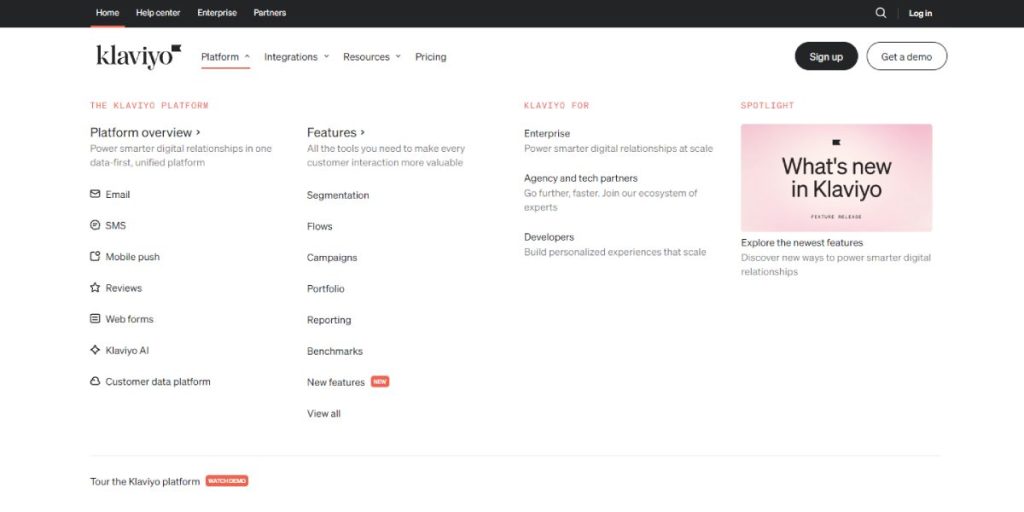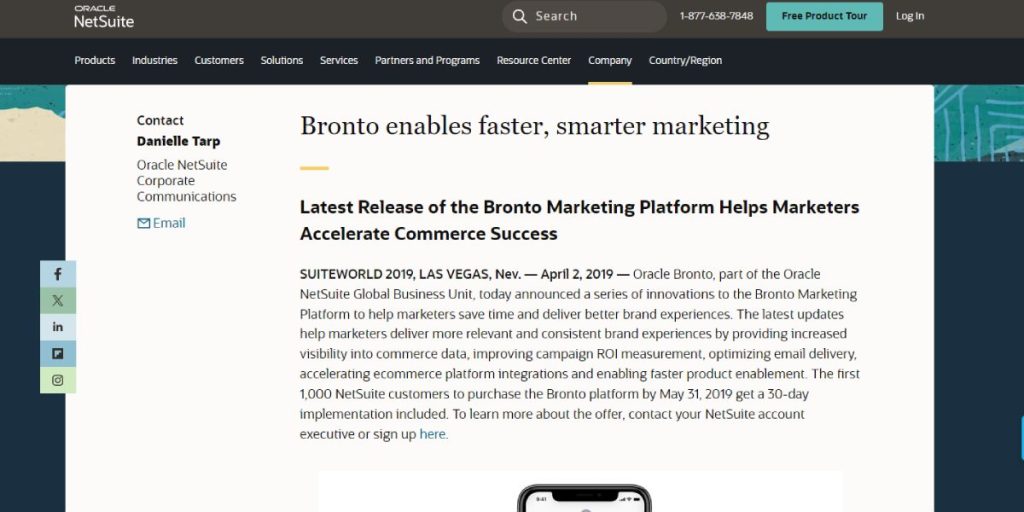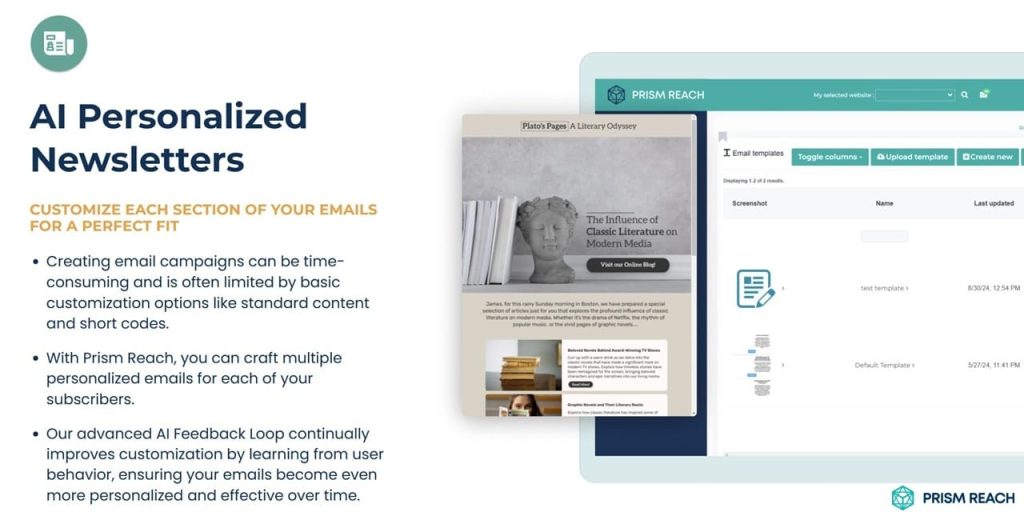In the ever-evolving world of digital marketing, email remains a cornerstone of customer engagement. As businesses seek to optimize their marketing strategies, the choice of email marketing software becomes crucial. Two platforms that have garnered significant attention are Klaviyo and Bronto. However, the landscape has shifted dramatically with Oracle NetSuite’s announcement of Bronto’s end-of-life status, leaving many marketers at a crossroads.
This comprehensive comparison delves into the features, strengths, and limitations of Klaviyo and Bronto, offering insights to help businesses make informed decisions about their email marketing tools. Additionally, we’ll introduce an innovative alternative that’s reshaping the industry: Prism Reach. By the end of this article, you’ll have a clear understanding of which platform aligns best with your marketing needs and how Prism Reach can elevate your email campaigns to new heights.
Key Facts
- Klaviyo specializes in eCommerce marketing with advanced AI-driven features and personalization.
- Bronto, once a robust enterprise solution, is no longer supported as of May 31, 2022.
- Prism Reach emerges as a cutting-edge AI-powered alternative, focusing on deep personalization for publishers and content creators.
- Klaviyo offers seamless integration with major eCommerce platforms like Shopify, WooCommerce, and Magento.
- Bronto was known for its extensive integration with ERP systems, particularly NetSuite.
Klaviyo vs Bronto: A Tale of Innovation and Legacy
Klaviyo’s Rise in eCommerce Marketing

Klaviyo has established itself as a leader in email marketing, particularly for eCommerce businesses. Its success stems from a data-driven approach and seamless integration with popular eCommerce platforms like Shopify, WooCommerce, and Magento. The platform’s strength lies in its advanced AI-driven features and personalization capabilities. Klaviyo offers ultra-specific segmentation with unlimited conditions for creating personalized campaigns, including both SMS and email marketing. Real-time reporting and analytics allow users to track ROI and measure campaign performance effectively. The platform’s drag-and-drop automation workflows simplify the process of setting up email campaigns such as abandoned cart reminders and welcome series. Klaviyo’s focus on customer success, with personalized onboarding and continuous support from dedicated teams, further enhances its appeal to businesses of all sizes.
Bronto’s Legacy and Decline

Bronto, once a prominent player in the email marketing industry, has faced a significant setback with Oracle NetSuite’s announcement of its end-of-life status. Despite its robust features tailored for large enterprises, including extensive A/B testing capabilities and strong integration with ERP systems like NetSuite, Bronto’s future is now uncertain. The platform was known for its high-level segmentation capabilities, event-triggered campaigns, and personalized email content based on customer behavior and purchase history. However, Bronto’s limitations became apparent over time, including issues with list capacity, where users reported difficulties in hosting large volumes of contacts without performance drops. The platform’s complex setup and steep learning curve made it less suitable for small teams with limited technical resources. With the end-of-life announcement, Bronto users are now forced to seek alternative solutions, marking the end of an era in email marketing.
User Interface and Automation Comparison
Klaviyo’s user interface stands out for its accessibility and ease of use, catering to marketers of all skill levels. The platform’s drag-and-drop automation workflows simplify the creation of sophisticated email campaigns. Klaviyo’s segmentation capabilities are particularly noteworthy, offering ultra-specific options with unlimited conditions for highly personalized campaigns. These features are enhanced by AI-backed recommendations, allowing for data-driven marketing strategies.
In contrast, Bronto’s automation, while powerful, was less user-friendly compared to Klaviyo’s system. Bronto offered customizable workflows for email sequences, but the setup could be complex and often required more technical knowledge. While Bronto’s segmentation features were extensive, they lacked the real-time dynamic updates that Klaviyo provides, potentially limiting the agility of marketing campaigns in fast-paced eCommerce environments.
Pricing Models and Accessibility
Klaviyo’s pricing structure is designed to accommodate businesses of all sizes, offering a flexible, scalable model that starts with a free tier for small businesses. This pay-as-you-grow approach makes Klaviyo an attractive option for startups and established companies alike. The platform’s pricing is transparent and based on the number of contacts, allowing businesses to easily predict costs as they scale. Klaviyo doesn’t charge setup fees, further reducing barriers to entry for smaller operations.
In contrast, Bronto’s pricing model was tailored primarily for large enterprises, often coming with a hefty price tag that could be prohibitive for smaller businesses. Bronto’s pricing was less transparent, requiring potential clients to contact sales for quotes, which could complicate budgeting and decision-making processes for marketing teams. This pricing structure limited Bronto’s flexibility and appeal to a broader range of businesses.
Integration Capabilities and Platform Support
Klaviyo excels in its integration capabilities, offering seamless connections with major eCommerce platforms such as Shopify, WooCommerce, and Magento. This extensive integration ecosystem extends to a wide array of third-party tools via an open API, allowing businesses to create a highly customized marketing tech stack. Klaviyo also supports real-time syncing and bi-directional integration with CRM tools, enhancing its utility for comprehensive customer relationship management. The platform’s social media marketing tools enable syncing with Facebook and Instagram for more targeted campaigns.
In contrast, Bronto’s integration strengths were primarily in its connection with ERP systems like NetSuite, reflecting its focus on larger enterprises. However, Bronto lacked out-of-the-box support for modern eCommerce platforms, which increasingly limited its appeal in the evolving digital marketplace. This disparity in integration capabilities highlights the diverging paths of these two platforms in adapting to the needs of contemporary eCommerce businesses.
Hidden Gems: Strategies to Leverage Klaviyo and Bronto Effectively
While Klaviyo and Bronto offer robust email marketing features, integrating these lesser-known strategies can significantly enhance your email marketing success by focusing on features that enhance targeting, engagement, and conversion rates.
1. Utilize Predictive Analytics in Klaviyo
Klaviyo’s predictive analytics feature allows you to forecast customer behavior, such as predicting which customers are likely to make a purchase soon. By leveraging this data, you can create targeted campaigns aimed at these high-potential customers, increasing conversion rates.
Practical Tips:
- Identify segments with high purchase probability and tailor offers specifically for them.
- Use predictive analytics to optimize send times based on when customers are most likely to engage.
- Integrate predictive insights with your automation workflows for more intelligent campaign triggers.
2. Dynamic Segmentation for Real-Time Targeting
Klaviyo allows for dynamic segmentation based on real-time data. This means you can adjust your audience segments instantly as user behavior changes, ensuring that your campaigns are always relevant and timely.
Practical Tips:
- Create dynamic segments that automatically update based on user interactions and behaviors.
- Leverage real-time data to send timely and relevant emails that match current customer interests.
- Combine dynamic segmentation with personalized content for maximum engagement.
3. Leverage Abandoned Cart Recovery Flows
Both platforms offer abandoned cart recovery features, but Klaviyo’s pre-built flows allow for quick setup. Customize these flows with personalized messages and product recommendations to recover lost sales effectively.
Practical Tips:
- Personalize recovery emails with the customer’s name and the specific products left in the cart.
- Include compelling incentives such as discounts or free shipping to encourage completion of the purchase.
- Test different email timings and sequences to determine what works best for your audience.
4. Integrate SMS Marketing with Email Campaigns
Klaviyo supports SMS marketing alongside email campaigns. Use this dual approach to reach customers through their preferred communication channels, enhancing engagement and conversion opportunities.
Practical Tips:
- Segment your audience based on their communication preferences to ensure you’re reaching them via their preferred channel.
- Coordinate email and SMS campaigns for cohesive messaging and increased touchpoints.
- Use SMS for time-sensitive promotions or reminders to complement your email marketing efforts.
5. Utilize Customer Lifetime Value (CLV) Segmentation
In Klaviyo, segment your audience based on CLV to target high-value customers with exclusive offers or early access to products. This strategy maximizes revenue potential by focusing on your most profitable customers.
Practical Tips:
- Identify high-CLV segments and tailor your campaigns to reward their loyalty.
- Create exclusive offers or VIP programs to enhance the customer experience for high-value segments.
- Monitor CLV trends to adjust your segmentation and targeting strategies over time.
Innovative Solutions by Prism Reach
As the email marketing landscape evolves, innovative tools like Prism Reach emerge as game-changers. Prism Reach, an AI-powered SaaS solution, offers deep personalization and advanced deliverability features that address the limitations of both Klaviyo and Bronto, ensuring your email campaigns are not only delivered but also highly effective.
Benefits of Prism Reach
- Enhanced Personalization: Prism Reach’s AI algorithms tailor email content to individual subscriber preferences, increasing engagement rates.
- Improved Deliverability: Advanced deliverability features ensure your emails land in inboxes, not spam folders.
- Seamless Integration: Easily integrates with existing systems, allowing for a smooth transition and enhanced email marketing capabilities without disrupting current workflows.
How Prism Reach Enhances Your Email Marketing
Prism Reach leverages artificial intelligence to analyze subscriber behavior and preferences, enabling highly personalized and relevant email content. This personalization not only enhances engagement but also improves sender reputation by ensuring that emails are anticipated and welcomed by recipients.
Additionally, Prism Reach’s optimal sending time feature uses predictive analytics to identify when each subscriber is most likely to engage with emails. Sending emails at these optimal times increases the chances of opening and interacting with the content, thereby boosting overall campaign effectiveness.
Prism Reach also integrates advanced deliverability features, including anti-spam checks, to proactively identify and mitigate potential spam triggers within your emails. By ensuring that your content adheres to best practices and avoids common spam filters, Prism Reach helps maintain a positive sender reputation and high inbox placement rates.

Prism Reach Features Addressing Deliverability Challenges
Prism Reach offers a suite of features specifically designed to tackle common email deliverability issues, ensuring that your campaigns reach their intended audience effectively.
- AI-Powered Personalization: Tailors email content based on detailed user avatars, enhancing relevance and engagement.
- Optimal Sending Times: Utilizes predictive analytics to send emails when subscribers are most likely to engage.
- Advanced Deliverability Features: Includes anti-spam checks and dynamic content selection to maximize inbox placement.
- Dynamic Content Selection: Automatically selects the most relevant content for each subscriber, reducing the risk of spam flags.
- Real-Time Engagement Metrics: Provides live updates on email performance, allowing for immediate adjustments to improve deliverability.
Practical Tips and Best Practices
Improving email deliverability is an ongoing process that requires attention to detail and adherence to best practices. Here are some actionable tips to enhance your email deliverability:
1. Maintain a Clean Email List
Regularly audit your email list to remove inactive or invalid email addresses. This reduces bounce rates and improves overall sender reputation.
Steps to Maintain a Clean List:
- Use double opt-in methods to ensure subscribers are genuinely interested.
- Remove hard bounces and inactive subscribers after a certain period.
- Implement re-engagement campaigns to win back dormant users.
2. Craft Relevant and Engaging Content
Ensure that your email content is relevant, valuable, and engaging to your audience. Personalized content based on subscriber behavior can significantly enhance engagement metrics.
Content Best Practices:
- Segment your audience based on demographics and behavior.
- Use dynamic content blocks to tailor messages to individual preferences.
- Include clear and compelling calls-to-action (CTAs) to drive engagement.
3. Optimize Email Design and Formatting
A well-designed email with clean formatting is more likely to be delivered successfully and engaged with by recipients. Avoid excessive use of images and ensure that your emails are mobile-friendly.
Design Tips:
- Use responsive design to ensure emails render well on all devices.
- Limit the use of large images and ensure they are properly optimized.
- Use clear headings, short paragraphs, and bullet points to enhance readability.

Prism Reach: The Future of Deliverability and Personalization
As email marketing continues to evolve, the importance of deliverability and personalization cannot be overstated. Prism Reach stands at the forefront of this evolution, offering a platform that not only addresses deliverability challenges but also enhances overall campaign effectiveness through advanced AI-driven features.
By leveraging Prism Reach, marketers can ensure that their emails not only reach their intended recipients but also resonate with them on a personal level. This dual focus on deliverability and personalization sets Prism Reach apart as a leading solution in the competitive email marketing landscape.
Call-to-Action
Don’t let email deliverability issues undermine your marketing efforts. Experience the power of AI-driven personalization and improved deliverability with Prism Reach. Visit our website today to learn more about how Prism Reach can transform your email campaigns and boost your engagement rates. Start your free trial now and see the difference for yourself!
Upgrade Your Email Marketing with AI Personalization!
Conclusion
While Klaviyo stands out as a robust, user-friendly option for eCommerce businesses, Bronto’s end-of-life status makes it an untenable choice for future-focused marketers. Prism Reach emerges as an innovative alternative, offering AI-powered personalization that could redefine email marketing strategies.
The comparison between Klaviyo and Bronto highlights the importance of choosing a platform that aligns with your specific marketing needs, technical resources, and growth strategies. Klaviyo’s data-driven approach and seamless integration capabilities make it a strong contender for many businesses, while Prism Reach’s cutting-edge AI technology offers exciting possibilities for those seeking the next level of personalization and deliverability.
As the digital marketing landscape continues to evolve, embracing innovative solutions like Prism Reach may be the key to staying ahead in the competitive world of email marketing. By focusing on advanced personalization, optimal sending practices, and robust deliverability features, Prism Reach ensures that your email campaigns not only reach their intended audience but also engage and convert them effectively.
Sources
- First Pier – Klaviyo Features Overview
- Bardeen AI – Complete Guide to Klaviyo Email Marketing
- Underground Ecom – Ultimate Guide to Klaviyo Email Marketing Strategies
- LinkedIn – Cool New Klaviyo Features You Probably Missed
- Marketing Automation Insider – Klaviyo vs Bronto: Pros, Cons, Pricing & Ratings